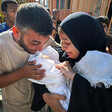Rights and Accountability 10 May 2019

Palestinian students walk past a school destroyed days earlier in Gaza City on 8 May.
APA imagesWill Israel opt for another war on Gaza, or will it finally lift the siege it has imposed on the territory for 12 years, at great cost to its two million Palestinian inhabitants?
That is the choice Prime Minister Benjamin Netanyahu and his generals face as armed factions in Gaza have given Israel until Monday to deliver on its commitments under a ceasefire agreement reached earlier this week.
That ceasefire brought to an end more than 48 hours of violence across the Gaza-Israel boundary that left 27 Palestinians in Gaza dead – 14 of them civilians killed by Israeli fire – as well as four civilian fatalities on the Israeli side.
The agreement reached on Monday is understood to be similar to understandings that brought an end to major Israeli offensives in Gaza in summer 2014 and November 2012.
The immediate steps expected by Palestinian factions include the reopening of the fishing zone, the transfer of funding from Qatar and the reopening of Gaza’s commercial crossings.
“Regular” life anything but
Regular life in southern Israel resumed immediately after the agreement.
But Gaza, along with the West Bank, remained under full closure as Israelis vacationed during national holidays.
Fishers were unable to set sail until Israel partly lifted restrictions on Friday.
“In Gaza, where the economy struggles for survival and residents face adverse humanitarian conditions, every additional day that passes until these further restrictions are lifted by Israel has severe implications,” Gisha, a human rights group that monitors Israel’s siege, stated on Tuesday.
“Traders cannot fulfill their business commitments, patients miss crucial appointments for life-saving treatment, and fishermen cannot feed their families,” Gisha added.
The rights group said that “Israel’s use of its control over the crossings to deliberately harm the civilian population in Gaza has to stop.”
Even when Israeli bombs aren’t being dropped, the status quo in Gaza – under air, sea and land blockade for more than a decade, and military occupation for half a century – is far from normal.
Every two in three Palestinians in Gaza is a refugee from lands now inside Israel, which forbids Palestinian refugees from exercising their right to return because they are not Jewish.
“Critically, since 1948, Israel has maintained brutal effective control over Palestine through the ongoing Nakba, the systematic denial of Palestinian human rights, and the creation of a regime of racial domination and oppression over the Palestinian people, amounting to the crime of apartheid,” the human rights organization Al-Haq stated this week.
Al-Haq slammed the European Union for its “abhorrent” stance of one-sided support for Israel during last week’s escalation.
The group demanded that the EU withdraw its positions that disregard international law and Palestinian lives and “apologize to the Palestinian people and the families of the victims of Israel’s most recent assault on the Gaza Strip.”
Protester killed
More than 200 Palestinians in Gaza have been killed during protests against these conditions since the Great March of Return began on 30 March 2018. Dozens more in Gaza have been killed by Israeli forces outside the context of protests.
The most recent fatality is Abdallah Jumaa Abd al-Al, 24, slain east of Rafah in southern Gaza during protests on Friday.
Four children and a paramedic were among more than 30 injured during protests on Friday, according to Gaza’s health ministry.
A farmer in Gaza was reportedly shot in the foot by Israeli occupation forces earlier in the day.
Meanwhile Israeli gunboats opened fire toward fishers in Gaza’s north.
Fire against Gaza fishers and farmers by Israeli occupation forces is routine; there were at least 30 such incidents along Gaza’s boundaries between 23 April and 6 May alone, causing three injuries.
Meanwhile, some 1,700 Palestinians injured during the Gaza demonstrations may require amputations because specialized treatment for what medical groups have described as war injuries resulting from Israeli army sniper fire is unavailable.
The UN is seeking $20 million for Gaza’s medical facilities which are “under very serious stress,” Jamie McGoldrick, a humanitarian official with the world body, stated this week.
Nearly 30,000 Palestinians have been injured during the Great March of Return, 7,000 of them with live ammunition. Some 120 amputations have already taken place, with 20 children among those who have lost a limb.
“We are running against the clock for some of these cases and osteomyelitis – bone infection – will be a crisis, and the need is to treat that, prevent that, otherwise we will have amputations,” McGoldrick said.
These are the conditions of “normal” life during periods of ceasefire in Gaza.
Israelis are readying themselves for the Eurovision Song Contest to be held in Tel Aviv next week.
At the same time, Palestinians are prevented from freely accessing their holy sites during Ramadan and are organizing marches along Gaza’s eastern boundary next Wednesday to commemorate the Nakba, the dispossession from their land before, during and after the establishment of the state of Israel in 1948.
Meanwhile, EU officials will be throwing a beachside rave for Israeli partygoers.






Comments
fine article
Permalink John Costello replied on
Al-Haq's statement is as perfectly distilled as any I've ever heard but they might consider accepting divestment from apartheid in lieu of an apology.